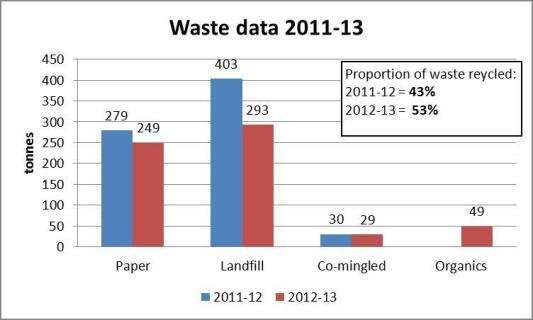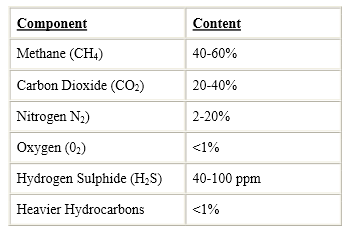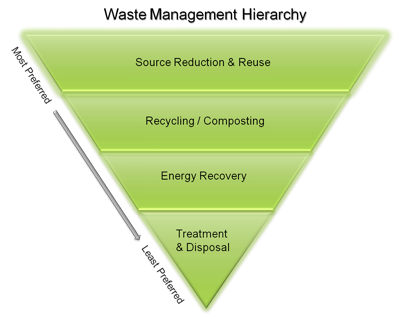Introduction
Usually, people dispose of unusable materials in litterbins. However, few of them are concerned with whatever happens after throwing the rubbish into the pit. Australia is experiencing one of the fastest growing economies in the world.
As a result, there has been amplified utilisation of resources in an attempt to meet various needs of Australians. Consequently, there is a high rate of waste generation due to the existence of fast growing industries. This situation has resulted in increased use of landfills to dispose of depleted materials. Indeed, this method is suitable for efficient disposal of biodegradable wastes.
However, at the back of landfill use are serious consequences that result from anaerobic digestion. The garbage that is disposed of in landfills harbours various microbes that disintegrate organic wastes into harmful gases that escalate global warming. This situation has created unending debates about establishing methods of waste disposal rather than using capped heaps.
Various researches have revealed that there are alternative ways that individuals, communities, and organisations can adopt to get rid of organic wastes. This essay provides an insight into waste management by examining the reasons why Australians should embrace recovery of energy from unused materials rather than dispose them of in landfills.
Waste Management in Australia
In Australia, various authorities in the municipalities are charged with the responsibility of creating awareness of waste management in an attempt to maintain sanitary and healthy environment for human survival. This practice focuses on keeping hazardous materials away from living and working places.
It also reduces pressure on raw materials that are used to make consumer products such as plastics through recycling and reusing them (Zaman & Lehmann 2011). The cost of unhygienic environment is much higher than that of observing strict management practices. In the wake of waste management, many companies have sprouted in Australia to deal with the menace (Zaman & Lehmann 2011).
Studies show that New South Wales alone has over 30-percent of the total waste management companies in Australia. The industry is approximated to generate more than 3-billion dollars revenue annually. It has offered employment to over 12,000 citizens. Its annual growth rate is about 7.5-percent. Statistics clearly indicate that more than 2700 organisations in Australia were involved in management of waste by the fall of 2012.
Disposal of Wastes in Landfills in Australia
The increasing rate of industrialisation in Australia has significantly led to generation of both biodegradable and non-biodegradable wastes. According to Parsons and Kriwoken (2010), there has been increased reliance on landfills as a primary method of disposing of organic wastes. Various surveys have revealed that the amount of waste that was disposed of in landfills has also amplified.
For instance, Parsons and Kriwoken (2010) confirm that the quantity of organic wastes that were heaped in landfills increased by approximately 15-percent from 2004 to 2009. Presently, the volume of waste that is buried in landfills has exceeded 250 million tons as compared to about 25 million tons in 2009. This difference statistics depicts the rate of industry growth in Australia that has resulted in massive generation of wastes.
The graph shows the tonnes of paper, landfill, co-mingled, and organic wastes that have been recycled in Australia between 2011 and 2013.

Graph 1: Waste recycling in Australia (Green & Dzidic 2014).
Impact of Landfill Use on the Environment and Society
The use of landfills has had various effects on the lives of Australians. Treloar (1998) reveals that leachate and gases that emanate from decomposing landfills expose human beings to varying health threats. Increased use of landfills in Australia has been characterised by corresponding levels of methane and carbon dioxide gases that aggravate global warming.
According to Pickin, Yuen, and Hennings (2002), leachate and gas that emanate from decomposing biodegradable waste in landfills have direct greenhouse effects. This situation has compelled the government to encourage conversion of waste into energy to save the environment from the menace.

Table 1: Estimated landfill emissions in Australia (Treloar 1998).
In addition, landfill waste exposes people to numerous infections that arise from bacteria and other pathogenic microorganisms that thrive in decomposing materials.
Classification of Landfill Waste
Numerous materials that end up in landfills determine the types of waste-to-energy management practices that should be executed to save the environment from pollution and devastation (Memon 2010). These types are grouped into two main categories. The first group comprises municipal wastes. Unused materials in this class are generated at the household level.
The local environmental authorities collect and dispose of the garbage in designated areas. The second category consists of commercial and industrial wastes that occur in larger quantities than the municipal wastes. Mainly, they are generated from business activities that involve large-scale processing of raw materials.
Wastes that result from construction sites or during demolition of buildings fall under this category. Such unused materials are removed using large skip bins. Other industrial wastes such as chemical effluents are hazardous in nature.
As a result, they require specialised handling. They are referred to as prescribed industrial wastes. The Environment Protection Regulations (EPR) of 2009 is charged with the responsibility of managing such effluents (Memon 2010).
National Waste-to-Energy Policy
The Australian national waste regulation was enacted in 2009 to promote management of wastes. The following were the aims of the policy.
- To avoid or reduce generation of waste
- To ensure proper management of waste as a resource
- To make use of safe and environmentally sound scientific methods for treatment, disposal, and recovery of waste
The policy identified six key areas that are well coordinated to create more clarity to the community and businesses. The first area involves taking responsibility to promote a safe and clean environment. It is a duty of every person to make sure that materials that are produced for use do not lead to generation of waste that is harmful to the environment.
Secondly, the policy advocates for market improvement. There is a need to establish market for resources that are recovered from waste to reduce pressure on natural resources. As a result, innovation in the sector needs to be accelerated. Thirdly, the policy aims at establishing sustainable ways of reducing waste generation. Furthermore, it highlights the need to reduce hazards.
Potentially harmful waste production should be abolished and energy recovery measures put in place. Lastly, updated waste and resource recovery information should be made available to policymakers. Provision of such evidence promotes assessment of the implemented regulations.
Waste Management Audit
According to Shan-shan and Lo (2007), waste management audits entail the use of formal and structured processes to quantify the types and amounts of waste that are generated by Australian organisations. The information obtained from the audit assists in the identification of existing waste management practices in attempt to determine ways of improving them.
Either an in-house or a contracted certified public accountant states the objectives of the process prior to the auditing process (Shan-shan & Lo 2007). This information enables determination of the suitable waste-to-energy conversion technology. Various objectives that can be used in the audit are listed below.
- To determine the composition of the waste generated and the quantity
- To identify opportunities of improving waste management strategies and systems
- To measure the effectiveness of the existing systems
- To collect information about waste minimisation
Non-hazardous Solid Waste Management in Australia
Non-hazardous waste consists of everyday unused materials such as product packaging, torn clothing, damaged furniture, and appliances. The municipal council normally collects this waste for disposal. A hierarchy for management of this kind of waste has been designed.
It is illustrated using an inverted pyramid that presents the most desirable practices at the top and the least desirable ones at the bottom.

Figure 1: Waste Management Hierarchy (Boyd 1994)
Waste to Energy (Energy Recovery)
Energy recovery is found at the second level from the bottom of the waste management pyramid. In Australia, energy recovery is still a less preferred method of waste disposal regardless of the efforts that various authorities and companies have made towards its implementation.
Energy recovery refers to the conversion of waste that is non-recyclable into heat (Green & Dzidic 2014). In the wake of increasing global warming and general environmental pollution, the many communities and governments around the world have pressured the Australian local authorities to initiate sustainable waste management programmes. This situation has resulted from the increased use of landfills.
The mounting pressure on the Australian authorities has compelled them to embark on a move to convert waste into energy. Various companies have come up with various waste-to-energy conversion technologies that are aimed saving the environment from amplified global warming effects.
To achieve this objective, the companies that have adopted a number of waste-to-energy techniques such as conventional combustion, anaerobic digestion, and advanced thermal technology to promote sustainable waste management. According to Parsons and Kriwoken (2010), wastes have both physical and chemical significances owing to their ability to generate bioenergy. As a result, these materials can be subjected to both primary and secondary energy conversion processes.
The waste-to-energy conversion techniques entail harnessing heat from materials that have a high calorific content through processes such as gasification, incineration, and/or pyrolysis (Parsons & Kriwoken 2010). The heat energy is used to generate electricity that is used for both domestic and commercial purposes.
For instance, some industries such as sugar millers heap huge wastes on daily basis. Some of such companies have recently begun using this waste to produce thermal electricity. This practice cuts their costs of production. At the household level, some people use animal waste to produce biogas, which is regarded as clean energy, through anaerobic digestion (Boyd 1994).
Economics of Energy Recovery
Australia is known as one of most notorious environment emitters of greenhouse gases due to increased industrialisation and use of landfills. Waste-to-energy initiatives are projected to improve collection of revenue through activities such as electricity generation.
Parsons and Kriwoken (2010) reveal that various Australian authorities have signed power purchase agreements with the companies that have taken the initiative to pursue energy recovery. On another perspective, establishment of waste-to-energy projects will encompass installation, operational, and maintenance costs.
Conclusion
Although various achievements on waste management in the have been realised, there is still a lot research and work that needs to be done. The government should conduct civic education to sensitise people to ways of reducing waste generation. The rate at which natural resources are being used to make products is a major cause of waste generation.
At some point, is hard to imagine the availability of such resources in the next century. Recycling and reusing waste can slow down this rate effectively. Disposal of waste through landfills be a last resort when other forms have been proven ineffective for a particular kind of waste.
The waste capped in a landfill can otherwise create employment opportunities if a recycling plant is set up. Entrepreneurs should take advantage of the opportunities that are brought about by the availability of unused materials to venture in the multi-billion dollar waste management industry. This situation results in a clean environment that is necessary for a healthy nation.
References
Boyd, W 1994, ‘Agricultural waste management planning’, Journal of Soil and Water Conservation, vol. 49 no. 2, pp. 53.
Green, M & Dzidic, P 2014, ‘Social science and socialising: adopting causal layered analysis to reveal multi-stakeholder perceptions of natural resource management in Australia’, Journal of Environmental Planning & Management, vol. 57 no. 12, pp. 1782-1801.
Memon, M 2010, ‘Integrated solid waste management based on the 3R approach’, The Journal of Material Cycles and Waste Management, vol. 12 no. 1, pp. 30-40.
Shan-shan, C & Lo, C 2007, ‘The roles of grassroots local government in sustainable waste management in China’, International Journal of Sustainable Development and World Ecology, vol. 14 no. 2, pp. 133-144.
Parsons, S & Kriwoken, L 2010, ‘Maximising recycling participation to reduce waste to landfill: a study of small to medium-sised enterprises in Hobart, Tasmania, Australia’, Waste Management and Research, vol. 28 no. 5, pp. 472.
Pickin, J, Yuen, S & Hennings, H 2002, ‘Waste management options to reduce greenhouse gas emissions from paper in Australia’, Atmospheric Environment, vol. 36 no. 4, pp. 741-52.
Treloar, J 1998, Recovery and Use of Landfill Gas in Adelaide, South Australia. Web.
Zaman, A & Lehmann, S 2011, ‘Urban growth and waste management optimisation towards ‘zero waste city’’, City, Culture and Society, vol. 2 no. 4, pp. 177-87.